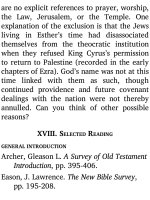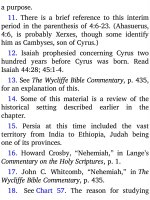Jensens survey of the old testament adam 267
Bạn đang xem bản rút gọn của tài liệu. Xem và tải ngay bản đầy đủ của tài liệu tại đây (117.87 KB, 4 trang )
things rst. Not long after God led the Jews
out of exile back to Jerusalem, the people
became self-satis ed and began to neglect
the things of the Lord. They were building
houses for themselves, but hardly a soul was
grieved that the Temple-building project,
discontinued fourteen years earlier, was yet
at a standstill. To such a stagnant situation,
Haggai was sent with God’s message.
I. BACKGROUND
(Scan the book of Haggai before
proceeding with this study of background.)
A. THE MAN HAGGAI
Very little is known of the prophet
Haggai. His name appears in two verses
outside of his own book: Ezra 5:1; 6:14.
Read these verses.
1. Name. The name Haggai means “festal”
or “festive.” The root of the word Haggai
has the literal meaning of celebration. Read 1
Samuel 30:16, where the Hebrew word is
translated “dancing.” What ever led Haggai’s
parents to this name, it was well chosen, for,
as one writer has observed, “Haggai was one
of the few prophets who had the
inexpressible pleasure of seeing the fruits of
his message ripen before his very eyes.”4
2. Home. Haggai was probably born in
Babylon during the captivity years. We know
nothing about his family. He was among the
rst contingent of Jews returning to
Jerusalem, under the leadership of
Zerubbabel, in 536 B.C. (Ezra 2:2).
3. Ministry. The prophet Haggai is often
referred to as “The Successful Prophet.” No
prophet saw a faster response to his message
than did Haggai. Also, he has been called
“the prophet who said it with bricks.” This is
because the main subject of his message was
the completion of the Temple structure.
Haggai and Zechariah were companions in
the prophetic ministry (Ezra 5:1; 6:14). How
was the principle of co-working practiced in
New Testament times? (Cf. Mark 6:7.) What
are the advantages of a dual witness?
B. THE BOOK OF HAGGAI
1. Date. The book of Haggai clearly dates
itself: “second year of Darius the king,”
(1:1), which was 520 B.C. All four messages
recorded in the book bear the same date, as
to year.
2. Historical setting. As mentioned earlier,
the Temple project is the focal issue of the
book of Haggai. The story of that project, in
the early years, is tragic. To fully appreciate
the prophet’s burden, the following
sequence of events, predating his writing,
should be learned. (Read the Bible
references, and locate some of the dates on
Chart 57.)
586 B.C. Jerusalem and the Temple are
destroyed by the Babylonian invaders.
539 B.C. Fall of Babylon. The Persian Empire,
ruled by King Cyrus, becomes the world
power. The Jews in exile are not subject
to Cyrus.
538 B.C. God moves Cyrus to issue a decree
permitting and encouraging the Jews to
return to their homeland (Ezra 1:1-4).
536 B.C. First return of Jews under
Zerubbabel. Read Ezra 1:5—2:70 and
Nehemiah 12. The total number of
returnees: about fifty thousand (see Ezra
2:64-67).
536-535 B.C. Altar of burnt offerings built at
Jerusalem, on the site of the Temple
ruins. Feast of Tabernacles kept.
Sacrifices observed (Ezra 3:1-6).
Foundations of the Temple laid (Ezra









